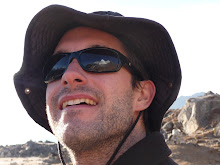A few weeks back I took a weekend trip to the department of Chalatenango. In addition to passing through Guarjila, the town where my good friend Dave did volunteer work while a student at Notre Dame, the highlight was spending time in and around the small town of Arcatao.
Arcatao
I expected Saturday to be an early night, but I ended up getting more than I bargained for. Padre Miguel invited me, along with a group of young Jesuit seminarians, to attend the graduation party for Guadalupe, a young man who had just finished her studies at the UCA, the Jesuit University in San Salvador. Guadalupe had received a scholarship through the church’s foundation on the condition that she returned to serve her community. We enjoyed a terrific meal, dancing, and great conversation.
Ladies Night
All right, there are a couple guys getting into it...
Jesuit Semanarians (plus a host) enjoying dinner
One thing that really struck me during the services was the iconography in the churches. Pictures of Monseignor Romero (former arch-bishop who was assassinated by the government – more on him in a future post) and Jon Cortina (a Jesuit priest who was dedicated to finding children missing during the civil war) were up on or next to the altar along with Jesus on the cross. On both sides of the altar were pictures of all the people who “disappeared” during the civil war. Along the walls next to the pews, the Stations of the Cross were interspersed with imagines of the martyred Jesuit priests and people suffering from government’s brutal crackdown in the 1970s and 80s. Padre Miguel’s sermons spoke to the importance of average citizens organizing themselves, working together to help their communities and to fight oppression.
Monseignor Romero is seated at the right hand of Jesus
Pictures of the disappeared on both sides of the altar
Modified Stations of the Cross: Massacre
Modified Stations of the Cross: Martyred Priests
El Salvador’s history does make me reflect on the role of the church in politics, but I cannot say I understand the founding principles of the country well enough to draw a comparison to the United States. I cannot say its founders were as committed to the separation of church and state for which Madison, Jefferson and others so passionately advocated. The society here also just tends to be more religious in nature that the U.S. – heck the country’s name means “The Savior”. One thing is clear is that this debate won’t be resolved any easier than it will be in the States. We will both continue to try and keep the appropriate distinction between the two, while recognizing that faith influences our perspectives and decisions no matter how hard we may try and keep it separate from our politics.
"Savior of the World", one of San Salvador's main landmarks
(On a side note, I learned that Madison, WI is the sister city of Arcatao! During the civil war, representatives from Madison snuck behind guerilla lines to better understand the reality on the ground.)
After attending the third mass and grabbing a quick lunch of rice, beans and tortillas at the home of a parishioner, we hit the road heading towards Nueva Concepcion for the town’s annual corn festival. We were accompanied by the young Jesuit seminarians and a collection of parishioners. The event was small town festival at its finest: families out celebrating with their young children, entrepreneurs selling food and drink, people strolling in the streets, and local bands strutting their stuff.
Are you ready to shuck?















No comments:
Post a Comment